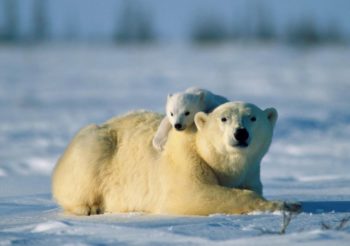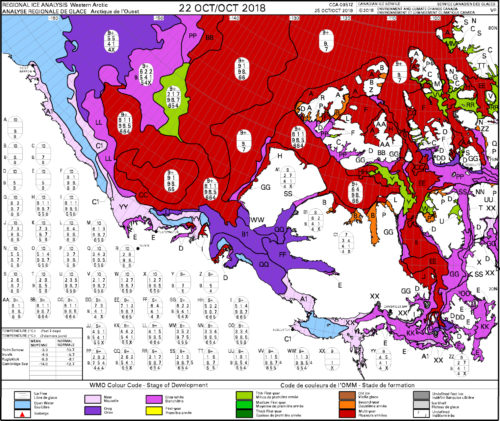
However, decades of evidence suggests that onshore oil exploration in the Arctic National Wildlife Refuge is unlikely to harm the few female bears that come ashore in Alaska to make maternity dens.
Here is my rebuttal to Derocher’s claims, all of which I’ve dealt with previously.
1) Quote: Southern Beaufort bears show “very clear effects climate change and the reduction in Arctic sea ice”.
The Southern Beaufort Sea has unique sea ice characteristics that make it inappropriate for comparison to any other Arctic region: what happens to SB polar bears is not comparable to other populations.
The effects being attributed recently to reduced sea ice have been documented in the past as the result of thick ice conditions in late winter and early spring (Crockford 2017, 2018; Reimer et al. in press).
2) Claim: sea ice loss will eventually harm polar bears.
Polar bear biologists have been predicting this outcome since 2005 but so far, the catastrophe has not materialized despite the dramatic drop in summer ice coverage in 2007 that has was not predicted to occur until 2050.
As I have previously explained (Crockford 2017, 2018), there is still abundant sea ice in winter and early spring when polar bears actually require it for hunting, mating and giving birth and that is not expected to change.
3) Claim: For the Arctic, sea ice is like the soil in the forest.
I’ve explained why this analogy of Derocher’s is nonsense. Arctic sea ice is like a pond that dries up in the summer: it does not disappear entirely nor is it ever expected to do so.
4) Quote: “If you increase the length of their fasting period — the ice breaks up sooner in the spring and forms later in the fall — you’re asking the bears to do more with less.”
Derocher and others have assumed since 2005 that this will happen but so far, it has not. A prediction is not evidence: the length of the ice-free season has not been increasing steadily over time.
On the contrary, sea ice coverage has been amazingly stable since 2007, with some year-to-year variation.
In fact, the two subpopulations claimed to have declined in abundance (Western and Southern Hudson Bay) had two of the earliest freeze-ups on record in 2017 and 2018 and ice coverage is still well above average.
Freeze-up was also early in 2015. Ice formation in the Central Canadian Arctic and the Southern Beaufort was also earlier than average this year and by mid-November, there was ice surrounding all major polar bear denning areas except Svalbard.
5) Claim: More SB polar bears are denning on land rather than on the sea ice due to loss of multiyear ice and are therefore subject to disturbance by onshore oil exploration in Alaska’s Arctic National Wildlife Refuge.
One of the regions where multiyear ice is still abundant is in the Southern Beaufort sea off Alaska.
Despite an apparent increase in numbers of bears denning onshore compared to the 1980s, most Southern Beaufort bears still make their dens on the sea ice offshore (Amstrup and Gardner 1994; Schliebe et al. 2005; Stirling and Andriashek 1992).
The sea ice chart below from Canadian Ice Services shows a mass of multiyear ice in the Eastern Beaufort off Alaska and western Canada (dark red areas) in October that has gradually shifted westward:
Multiyear ice (dark red) at 26 November 2018 off Alaska and western Canada:
As an example, here is the USGS tracking record for Alaska female polar bears with satellite collars at the end of December 2012: four out of five were on the sea ice, almost certainly in maternity dens (the locations move because the ice moves):
Bottom line: Derocher apparently has failed to notice that polar bear sob stories no longer win public sympathy for ‘action’ on global warming because the polar bear as a climate icon is dead.
Alaskan polar bears are unlikely to be negatively affected by onshore oil exploration or drilling activity in the Arctic National Wildlife Refuge, especially given existing rules in place for avoiding disturbance laid out decades ago in the Marine Mammal Protection Act (1972).
Read more at Polar Bear Science



















Gulio balsowood planes wacky wings wonderbird
The polar bear is the perfect mascot. Tell any nonsense story you want. Who is going to go up North to verify/invalidate.
If someone does, just squash them as deniers.
So simple.
I don’t know if any procedures have changed since the 1960’s. At that time, seismic oil exploration in Alaska was done in the winter to avoid damage to the permafrost. Listening to the stories told by some of my co-workers who worked there – it’s not at all pleasant. Disturb a few bears? Very unlikely…..
Exactly. This common sense perspective will have to be put on ice.
The Polar Bear the mascot of the Global Warming/Climate Change Alarmists wackos was never endangred in the first place their just being used by the Eco-Freaks to stop America from being oil indepentdant